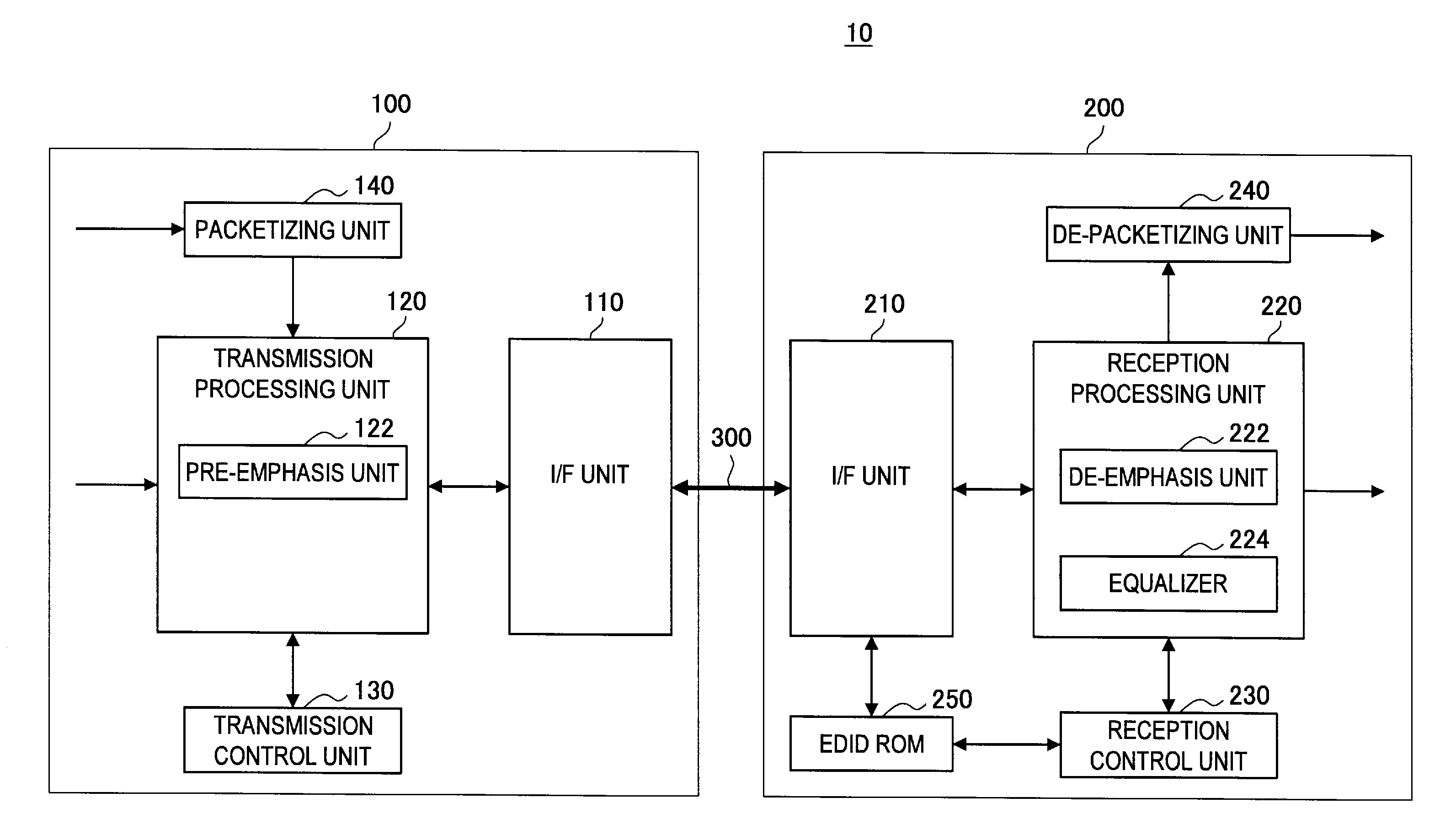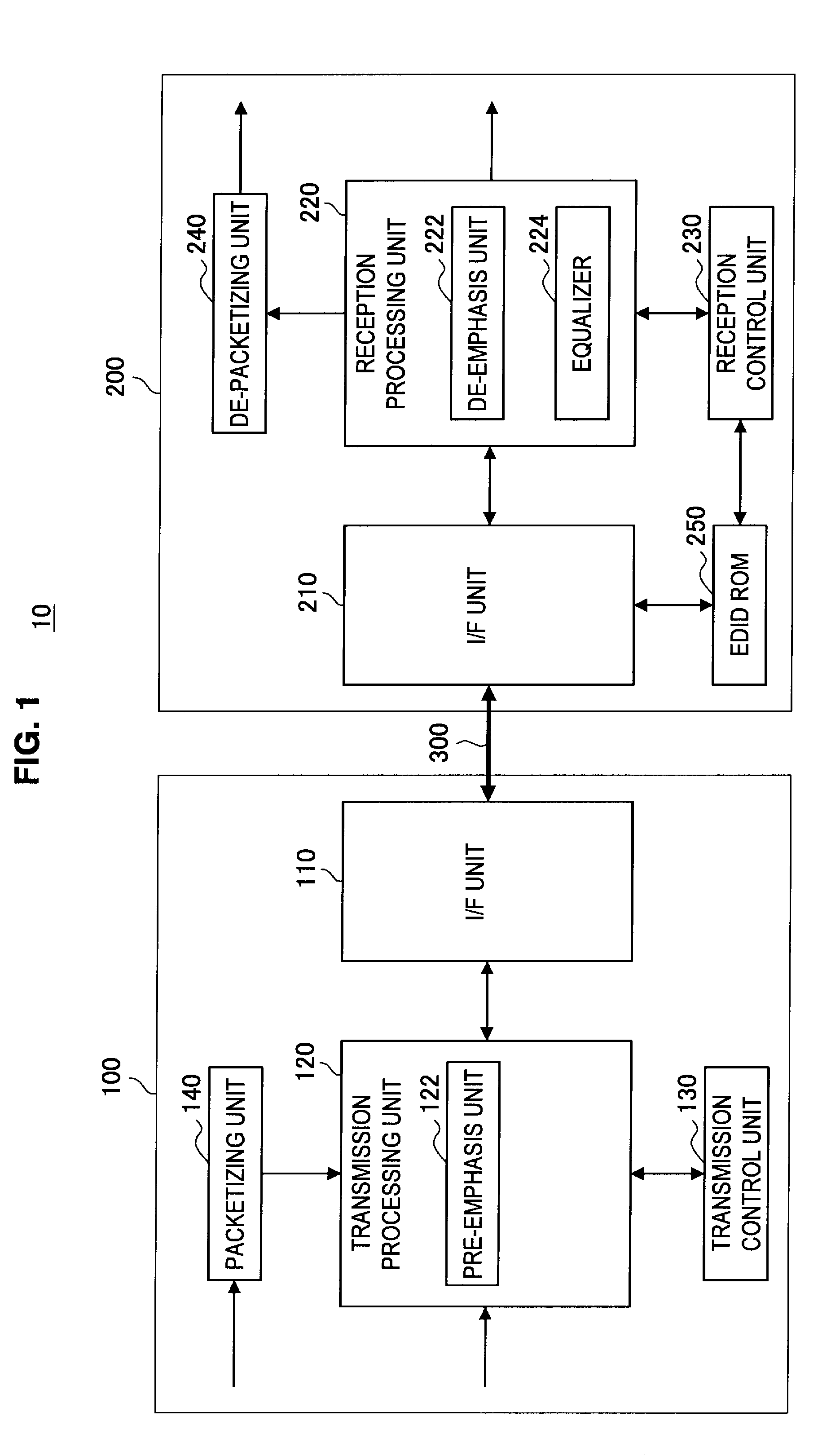Transmitter device, receiver device, transmission method, reception method, and transmitter/receiver device
a technology of transmitter/receiver device and receiver device, which is applied in the direction of selective content distribution, television system, instruments, etc., can solve the problem of loss of compatibility with conventional signals (hereinafter referred to as normal signals)
- Summary
- Abstract
- Description
- Claims
- Application Information
AI Technical Summary
Benefits of technology
Problems solved by technology
Method used
Image
Examples
first embodiment
[0089]In the three embodiments of the transmission system 10 described below, control information is transmitted by means of AVI InfoFrame transmitted through a TMDS channel. At this time, the transmitter device 100 determines if the receiver device 200 is compatible with the pre-emphasis transmission on the basis of the EDID information acquired via the DDC line.
[0090]As the acquisition of the EDID information and transmission of the AVI InfoFrame are currently conducted, the first embodiment is advantageous in that it is easy to implement. However, the DDC line and the TMDS line, which are respectively used to acquire the EDID information and transmit the AVI InfoFrame, are only capable of one-way transmission. Therefore, even if control information is transmitted to the receiver device 200 to switch it to the de-emphasis mode corresponding to the pre-emphasis transmission, it would be impossible to check if the operation mode has actually been switched. Therefore, a second embodi...
second embodiment
[0113]Next, the second embodiment in which a CEC control signal is used will be described with reference to FIGS. 8 and 9. As described above, as the CEC line allows two-way communication, the transmitter device 100 can, after having transmitted a control signal for switching the operation mode of the receiver device 200, receive response information from the receiver device 200. The reception control unit 230, upon switching the operation mode of the receiver device 200 to the de-emphasis mode, transmits the response information to the transmitter device 100 via the CEC line. Then, the transmission control unit 130, upon checking the response information, switches the operation mode of the transmitter device 100.
[0114]As shown in FIG. 8, the transmitter device 100 and the receiver device 200 can mutually transmit CEC control signals via the CEC line. As the CEC line allows two-way communication, the receiver device 200 can return response information corresponding to the control in...
third embodiment
[0120]Next, the third embodiment will be described in which the operation mode is switched using packets of the Ethernet (Registered Trademark) through a HEAC, with reference to FIG. 10.
[0121]When the transmitter device 100 and the receiver device 200 are connected via a cable (S404), the transmitter device 100 supplies power to the EDID-ROM in the receiver device 200, and the receiver device 200 returns a HPD signal, whereby the transmitter device 100 detects the HPD (S402). Then, the reception control unit 230 transmits a packet, which indicates information on the reception capability of the receiver device 200, to the transmitter device 100 using the HEAC (S406).
[0122]Then, as in step S108 and step S110 in FIG. 6, the transmission control unit 130 identifies the format of a signal to be transmitted (S408), and determines if the bandwidth should be increased (S410).
[0123]If it is determined that the bandwidth should be increased in step S410, the transmission control unit 130 dete...
PUM
 Login to View More
Login to View More Abstract
Description
Claims
Application Information
 Login to View More
Login to View More - R&D
- Intellectual Property
- Life Sciences
- Materials
- Tech Scout
- Unparalleled Data Quality
- Higher Quality Content
- 60% Fewer Hallucinations
Browse by: Latest US Patents, China's latest patents, Technical Efficacy Thesaurus, Application Domain, Technology Topic, Popular Technical Reports.
© 2025 PatSnap. All rights reserved.Legal|Privacy policy|Modern Slavery Act Transparency Statement|Sitemap|About US| Contact US: help@patsnap.com



